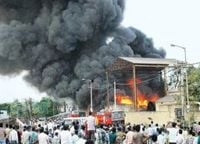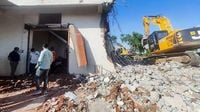At least 21 people have died and five others were injured in a massive explosion at an illegal fireworks factory in Disa, Gujarat, India, on April 2, 2025. The blast was so powerful that it sent debris, including body parts, stones, and metal, flying hundreds of meters away from the site of the explosion, according to local authorities.
Rishikesh Patel, a spokesperson for the state government, confirmed that the explosion caused the concrete roof of the factory to collapse. He noted that the factory was operating without a license, prompting the authorities to launch an investigation into the incident. "A huge explosion occurred at the factory, which led to the collapse of the concrete roof," Patel stated.
The police official, C.I. Solanki, reported that the death toll had risen to 21, up from an earlier estimate of 18 fatalities. This tragic incident serves as a grim reminder of the frequent explosions that occur at fireworks factories across India, primarily due to the lack of adherence to safety standards.
Meheir Patel, another government official, emphasized the severity of the explosion, stating, "The explosion was so strong that debris from some of the victims was found in a farm located 200 or 300 meters away from the site." This incident is not an isolated case; explosions at fireworks factories are alarmingly common in India, where safety regulations are often ignored.
In the past, similar incidents have resulted in numerous casualties. For instance, in 2024, 11 people were killed in a fireworks factory explosion in Madhya Pradesh, while in 2019, 18 fatalities were reported in a similar incident in Batala, Punjab. Additionally, that same year, 10 more people lost their lives in a fireworks factory explosion in Badohi, Uttar Pradesh.
The current explosion has reignited discussions about the need for stricter enforcement of safety regulations in the fireworks industry. Despite the tragic history of such incidents, many factories continue to operate without proper oversight, putting workers and nearby residents at risk.
Local residents expressed their shock and grief over the incident, with many calling for immediate action to prevent future tragedies. "How many more lives need to be lost before something is done?" one resident lamented. The community is now left to mourn the loss of their neighbors and friends while grappling with the reality of living in an area where such dangers are prevalent.
As investigations continue, the focus remains on holding those responsible accountable and ensuring that safety measures are implemented across the industry. The government has promised to look into the matter thoroughly, but past experiences suggest that change may come slowly.
This explosion highlights the urgent need for reform in India's fireworks manufacturing sector, where the allure of profit often overshadows the necessity for safety. Until comprehensive regulations are enforced, tragedies like this one may continue to occur, leaving families shattered and communities in mourning.





